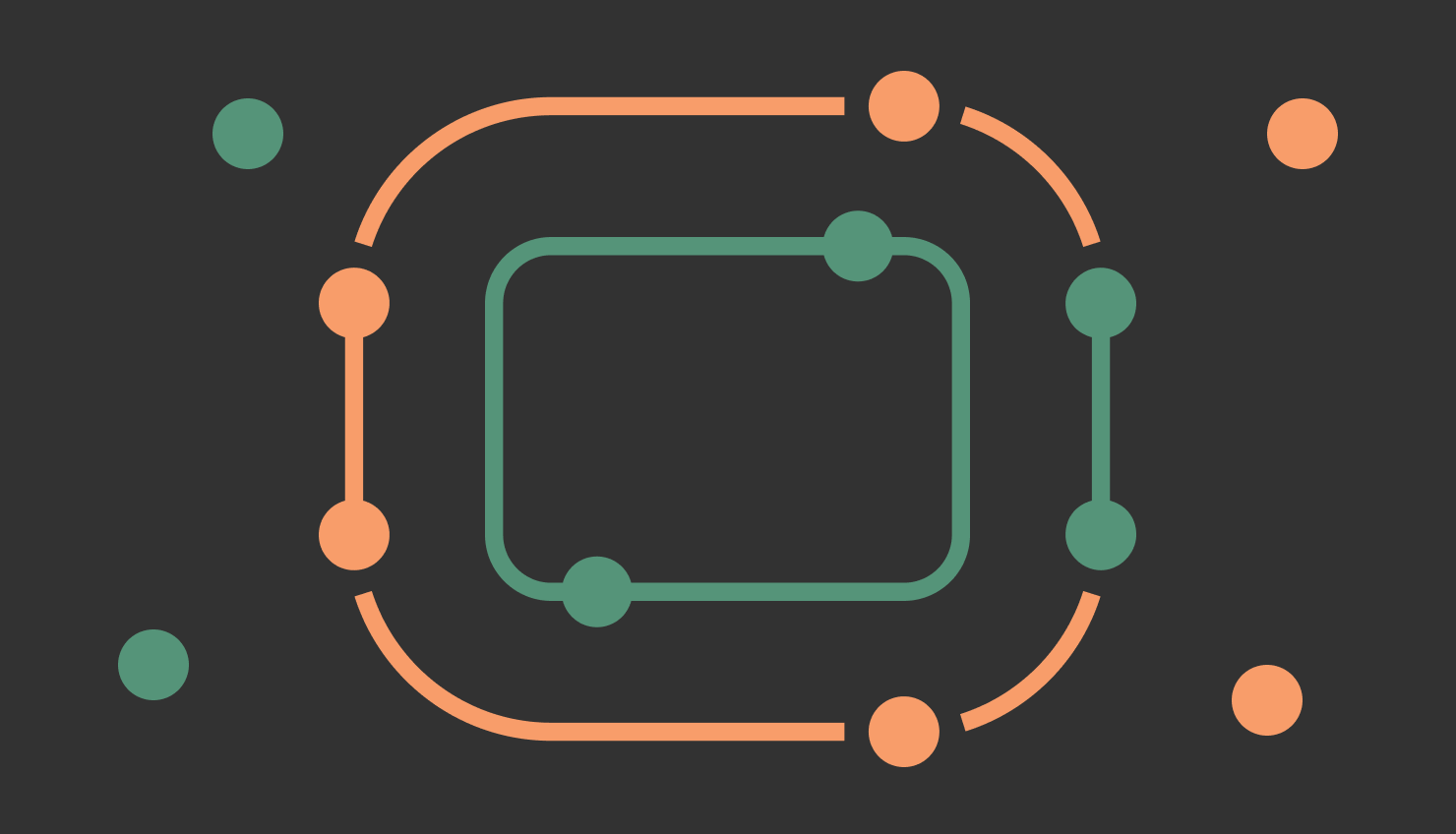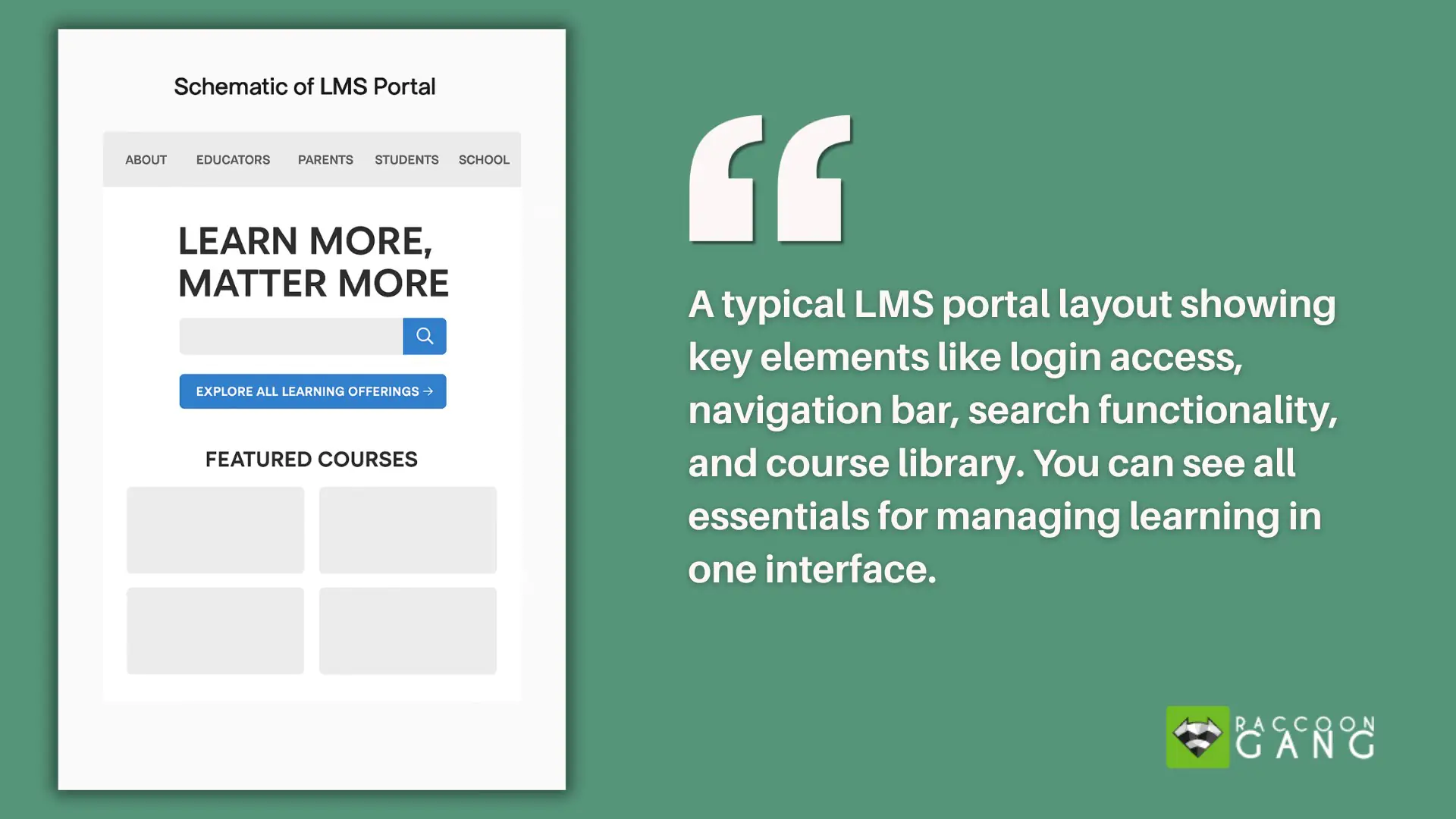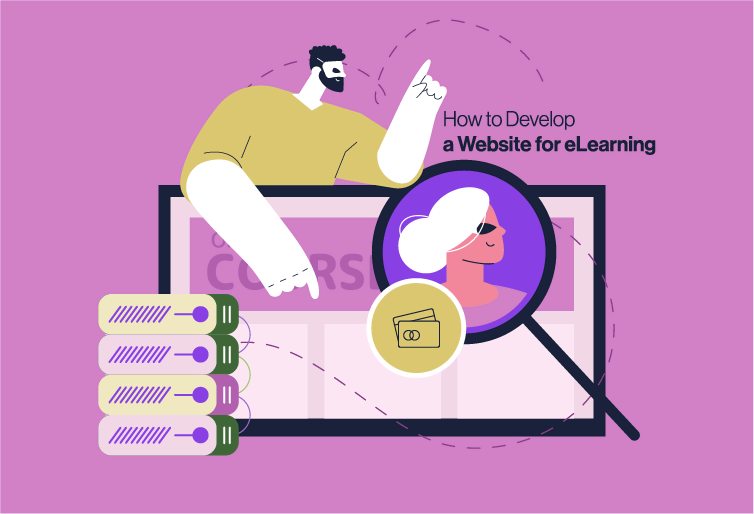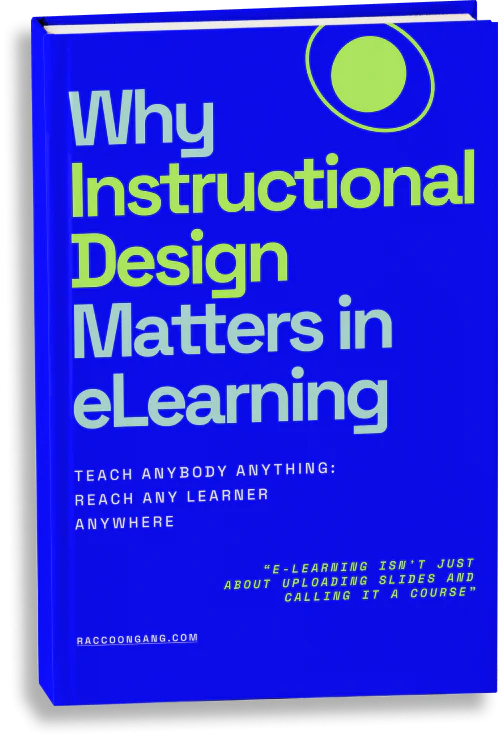An LMS portal is a login-based, user-facing part of a Learning Management System. A Portal is not the LMS itself, but rather an essential part of it where users log in, access content, manage training, and track progress. In 2025, it’s the front door to an online training session of every LMS.
When you enter through these front doors, a login-based learning portal controls who logs in, what visitors see first, and how they navigate through courses. The functionality of LMS portals usually involves the presence of such things as user dashboards, personalized learning paths, course progress tracking, and role-based access.
“To make it easier to understand the difference, think of an LMS as an internal system (it stores data and all the logic of your course). A portal is the main screen of your LMS. It is from here that users can further navigate your learning platform within the framework of their assigned roles and permissions.” — E-learning Development Specialist, at Raccoon Gang.
As training demands grow and hybrid work becomes standard, the LMS portal is no longer optional. In this article, we’ll break down the key features of LMS portals, compare business and education use cases, and explain how to build a custom solution that fits your needs in 2025.
Key Features of a Modern LMS Portal
A modern LMS portal is the user-facing layer of your learning system. It’s where learners log in, access training, and track their progress—and where admins manage content and visibility.
Login-based access is the foundation. Depending on the role—admin, instructor, or learner—each user signs in with a unique account and sees only what’s relevant to them. Learners view assigned courses and due dates. Instructors monitor progress and manage sessions. Admins handle permissions, reporting, and sometimes even homepage content and banners.
Course progress tracking is built in. Users can pause and resume where they left off. Many portals also include certification tools that issue credentials automatically when training requirements are met.
Some portals go even further—supporting blog posts, instructor profiles, and basic SEO tools to help position the organization as a trusted source of learning.
Together, these features make the LMS portal a central part of a scalable, flexible, and business-aligned training system.
Types of LMS Portals: Business vs. Education
Before we compare use cases, let’s clear up one common confusion about the difference between an LMS and an LMS portal. So, any LMS acts as a backend system through which you can deliver, manage, and track learning content.
On the other end of the scale is an LMS portal, which is the user entry point. It is through this interface that learners log in, access courses, and track their progress.
At this point, you might have a logical question — is it possible to have an LMS without a portal?
Technically, yes. But in practice, it’s impossible. Here’s why:
If we’re talking about an LMS as a system that stores courses, tracks progress, manages users, and generates reports, it can operate independently. However, without a portal as a user interface, neither students, instructors, nor administrators will be able to interact with any of it.
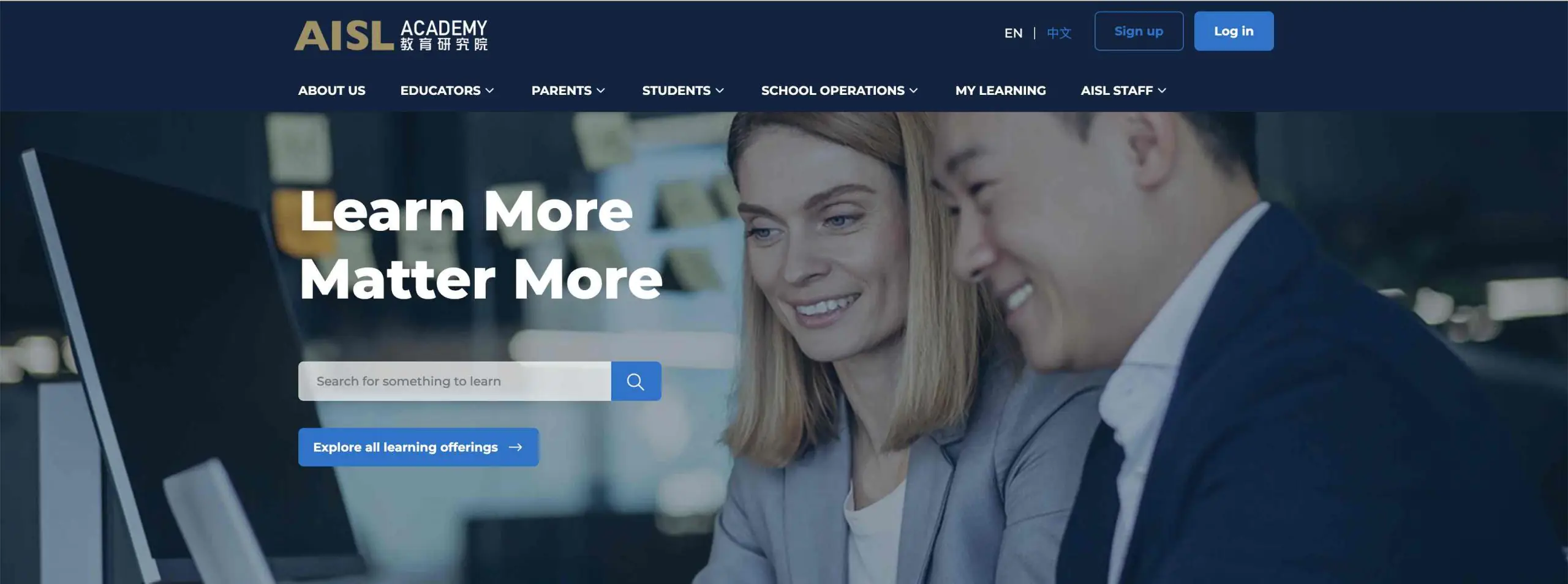
Portal homepage developed by Raccoon Gang for AISL Academy, featuring role-based navigation, search, multilingual support, and direct access to learning content.
How business and education online training portals differ
Each corporate LMS learning portal is literally a “portal” through which employees access training. Employees can immediately see their assigned courses, check their progress, and download earned certificates (if they already have them, of course). The portal helps managers assign role-based training, check who completed it, and view overall analytics. It supports everyday learning without requiring access to the system’s backend.
What are the features of an academic education LMS portal? This portal does the same thing, but for students and instructors. Students entering the portal can see course schedules, view materials provided to them, submit homework, and check grades. Instructors currently use the portal to upload content, post updates, manage assignments, and give feedback.
What users see in the LMS portal: business vs. education
| LMS Portal Element | Corporate Training Portal | Education LMS Portal |
| Login Page | Company-branded access with SSO or HRIS integration | Student portal login with campus credentials |
| User Dashboard | Role-based KPIs, assigned training, deadlines | Course list, grades, class schedule |
| Course Access | Job-specific learning paths, microlearning modules | Semester-based courses with syllabus |
| Notifications | Reminders for compliance, expiring certifications | Class announcements, assignment due dates |
| Progress Tracking | Training status, certification levels, team progress | Grades, attendance, module completion |
| Certificates | Auto-generated for completed courses | Issued after final assessments or exams |
Building a Custom LMS Portal: What to Consider
Okay! At this point, we’ve already figured out that an LMS portal gives us a login page. So, does a custom LMS learning portal give us more? What about a branded training environment? What about built-in blogging and SEO features? These components can help your organization.
What are the first things you should consider when building your LMS learning portal?
- Third-party integrations. You’ll definitely need to integrate your portal with tools like CRM systems, HR platforms, Zoom, or other systems you already use. A portal won’t replace them. It will only complement them (or, more importantly, connect them).
- UI/UX design. A well-structured portal guides users without confusion. It makes course navigation easy, keeps key actions visible, and reduces support requests.
- Role-based access. Instructors, administrators, and students should only see what they need to see. Courses, assignments, reports, or user management (each of these tools has its own user).
- Flexibility. Your enterprise LMS platform should work without downtime with 20,000 users as it does with 200. The portal should be ready for this.
- Frontend and backend connection. How much control do you want over the look and feel of your home page? Some teams want complete freedom over layout and content. Others prefer admin-level access to update text, post blog articles, or manage team profiles without developer help.
A well-built LMS learning portal is a practical extension for your LMS.
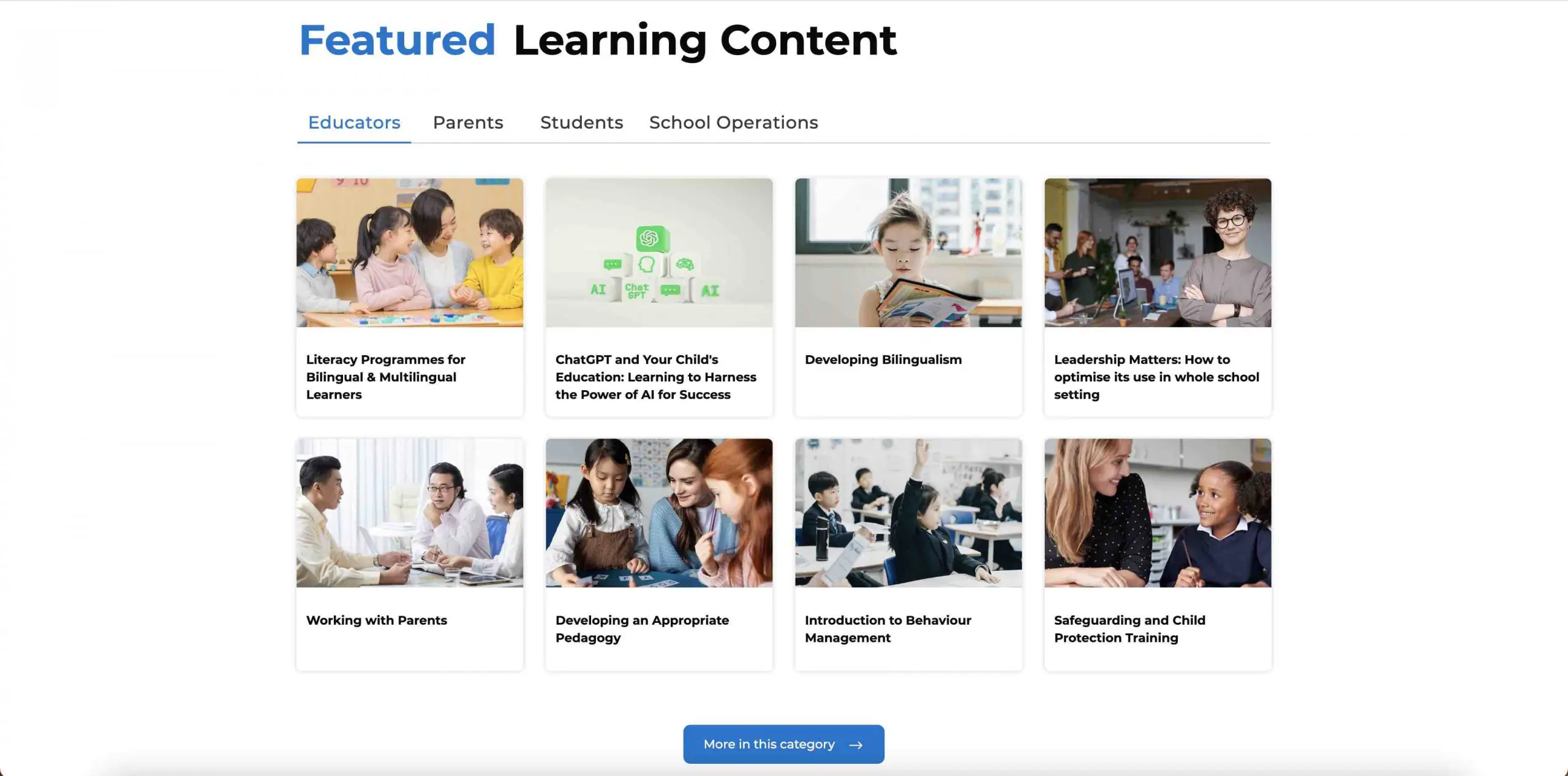
Featured learning content section of the AISL Academy portal, designed by Raccoon Gang. Users can browse courses by role—Educators, Parents, Students, or School Operations—making it easy to access relevant training materials.
Raccoon Gang Experience: LMS Portal Development
While our main service at Raccoon Gang is custom LMS development , we help our customers extend their Open edX® platforms with custom LMS portals too.
As part of our Open edX services, such as custom feature development, we have been helping to create the Open edX LMS portal for 10 years. We deliver a login-based learning portal that feels like a branded website but works as a native part of the learning system.
Marketing LMS Portal for Open edX LMS by Raccoon Gang includes:
- A custom admin panel. You take control over homepage and course page layouts without developer input.
- Built-in blog functionality. You become a publisher—able to share updates and boost organic reach with an SEO-friendly tool.
- Integration with the LMS backend. You maintain full learning access control for any user roles.
- Support for self-paced and instructor-led training at the level of your own CMS with different user roles and permissions.
“An LMS training portal is a hybrid between a marketing website and a functional training environment. On one side, it introduces the organization, builds trust through instructor profiles and blog content, and attracts learners through SEO-friendly pages. On the other, it connects directly to the LMS backend, giving users access to training materials, progress tracking, and certification tools. This dual role makes the portal both a public-facing site and a private learning space.” — LMS Feature Developer at Raccoon Gang.
Benefits of Using a Custom LMS Portal
We would like to once again draw your attention to the benefits that a custom LMS portal can bring to your organization. Here are some of the key benefits:
- Branded learner experience. Your training feels familiar and aligned with your main site.
- Content updates without developer help. The admin panel helps your team manage course page layouts and home banners without technical expertise.
- Built-in blog for content marketing. Share articles, updates, and insights to raise your team’s visibility and improve SEO.
- SEO tools that drive organic traffic. Attract organic traffic without breaking the bank.
- Seamless LMS integration. The portal stays in sync with your LMS backend, ensuring users move between content, tracking, and dashboards without friction.
- Faster go-to-market for new programs. Launch new courses and publish announcements without going through a full development cycle.
Conclusion: When the LMS Portal May Be Helpful
We started with the statement that an LMS portal is a login screen. In other words, it’s the front end of your entire learning ecosystem. But if we dig deeper, we’ll conclude that an LMS portal brings flexibility, control, and visibility to your training programs, while also acting as a branded entry point for your audience.
And if you’re interested in the technical side of the issue, your LMS portal can be hosted alongside the LMS backend or deployed independently. It all depends on your setup. This flexibility helps you manage the front end of your LMS without hardcoding.
And remember, an LMS without a portal is like a library without doors — there’s a lot of valuable content inside, but no one can access it.
